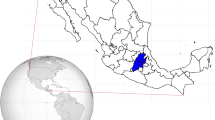Abstract
Libraries of rumen bacterial 16S rRNA gene sequences of Gayals (Bos frontalis) and Swamp buffaloes (Bubalus bubalis) were cloned and sequenced in the present work to compare the bacterial diversity with the third published library of Holstein cow. Sequence similarity of 97% was used as the definition of operational taxonomic unit (OTU). The majority of the 470 sequences retrieved fell into the phyla of low G + C subdivision (329 sequences) and Cytophaga–Flexibacter–Bacteroides (CFB, 123 sequences) with the percentages of 70 and 26.2, respectively. The remaining clones belonged to the phyla of Proteobacter, high G + C gram positive bacteria (HGCGPB) and Spirochaetes, accounting for 3.8% totally. Only 73 clones (25 OTUs, 15.5%) could be closely related to cultured representatives. However, a larger fraction was related to uncultured representatives. Holstein cow may have more representatives of cultural bacteria and there were more uncultured clones for Gayals. The percentage of cultural representatives was 24, 13.3 and 9.5 for Holstein cow, Swamp buffaloes and Gayals, respectively. Twenty-three OTUs of the 236 ones appeared in more than one library, five of which were cultural. Selenomonas ruminantium, Ruminococcus flavefaciens and Butyrivibrio fibrisolvens were found in two different libraries, while Succiniclasticum ruminis and Pseudobutyrivibrio ruminis were found in all three libraries. Some of the animal-specific bacteria that had not been described previously in the ruminal ecosystem, e.g. Allisonella histaminiformans for Gayals and Staphylococcus sciuri for Swamp buffaloes were also recovered.






Similar content being viewed by others
References
Hungate RE (1966) The rumen and its microbes. Academic Press, New York
Stewart CS, Bryant MP (1988) The rumen bacteria. In: Hobson PN (ed) The rumen microbial ecosystem. Elsevier, London
Stewart CS, Flint HJ, Bryant MP (1997) The rumen bacteria. In: Hobson PN, Stewart CS (eds) The rumen microbial ecosystem, 2nd edn. Chapman and Hall, London
Amann RI, Ludwig W, Schleifer KH (1995) Phylogenetic identification and in situ detection of individual microbial cells without cultivation. Microbiol Rev 59:143–149
Whitford MF, Foster RJ, Beard CE, Gong J, Teather RM (1998) Phylogenetic analysis of rumen bacteria by comparative sequence analysis of cloned 16S rRNA genes. Anaerobe 4:153–163. doi:10.1006/anae.1998.0155
Deng WD, Xi DM, Mao HM, Wanapat M (2008) The use of molecular techniques based on ribosomal RNA and DNA for rumen microbial ecosystem studies: a review. Mol Biol Rep 35:265–274. doi:10.1007/s11033-007-9079-1
Tajima K, Arai S, Ogata K, Nagamine T, Matsui H, Nakamura M, Aminov RI, Benno Y (2000) Rumen bacterial community transition during adaptation to high-grain diet. Anaerobe 6:273–284. doi:10.1006/anae.2000.0353
An D, Dong XZ, Dong ZY (2005) Prokaryote diversity in the rumen of yak (Bos grunniens) and Jinnan cattle (Bos taurus) estimated by 16S rDNA homology analyses. Anaerobe 4:207–215. doi:10.1016/j.anaerobe.2005.02.001
Mondal M, Dhali A, Rajkhowa C, Rajkhowa C, Prakash BS (2004) Secretion patterns of growth hormone in growing captive mithuns (Bos frontalis). Zoolog Sci 21:1125–1129. doi:10.2108/zsj.21.1125
Xi DM, Wanapat M, Deng WD, He TB, Yang ZF, Mao HM (2007) Comparison of Gayal (Bos frontalis) and Yunnan Yellow Cattle (Bos taurus): in vitro dry matter digestibility and gas production for a range of forages. Asian-Aust. J Anim Sci 20:1208–1214
Stahl DA, Flesher B, Mansfield HR, Montgomery L (1988) Use of phylogenetically based hybridization probes for studies in ruminal microbial ecology. Appl Environ Microbiol 154:1079–1084
Lane DJ (1991) 16S/23S rRNA sequencing. In: Stackebrandt E, Goodfellow M (eds) Nucleic acid techniques in bacteria systematics. Wiley, New York
Maidak BL, Olsen GJ, Larsen N, Overbeek R, McCaughey MJ, Woese CR (1997) The RDP (ribosomal database project). Nucleic Acids Res 25:109–111. doi:10.1093/nar/25.1.109
Thompson JD, Higgins DG, Gibson TJ (1994) CLUSTAL W: improving the sensitivity of progressive multiple sequence alignment through sequence weighting, position-specific gap penalties and weight matrix choice. Nucleic Acids Res 22:4673–4680. doi:10.1093/nar/22.22.4673
Saitou N, Nei M (1987) The neighbor-joining method: a new method for reconstructing phylogenetic trees. Mol Biol Evol 4:406–425
Kimura M (1980) A simple model for estimating evolutionary rates of base substitutions through comparative studies of nucleotide sequences. J Mol Evol 16:111–120. doi:10.1007/BF01731581
Felsenstein J (1985) Confidence limits on phylogenies: an approach using the bootstrap. Evolution Int J Org Evolution 39:783–791. doi:10.2307/2408678
Good IL (1953) The population frequencies of species and the estimation of population parameters. Biometrika 40:237–264
Varel VH, Dehority BA (1989) Ruminal cellulolytic bacteria and protozoa from bison, cattle-bison hybrids, and cattle fed three alfalfa-corn diets. Appl Environ Microbiol 55:148–153
Van der Walt JG, Linington MJ (1989) A review of energy metabolism in producing ruminants. Part 1: metabolism of energy substrates. J S Afr Vet Assoc 60:223–227
Latham MJ, Brooker BE, Pettipher JL, Harris PJ (1978) Adhesion of Bacteroides succinogenes in pure culture and in the presence of Ruminococcus flavefaciens to cell walls in leaves of perennial ryegrass (Lolium perenne). Appl Environ Microbiol 35:1166–1173
Acknowledgments
The financial supports were provided by the Yunnan Provincial Natural Science Fund (2005C0038M), the Young Scientist Research Fund of Yunnan Provincial Education Commission (06Y052B) and the “863” Key Program (2008AA101001). We thank Prof. Dr. Roderick I. Mackie for critical review of the manuscript.
Author information
Authors and Affiliations
Corresponding author
Additional information
Shuli Yang and Songcheng Ma have contributed equally to this work.
Rights and permissions
About this article
Cite this article
Yang, S., Ma, S., Chen, J. et al. Bacterial diversity in the rumen of Gayals (Bos frontalis), Swamp buffaloes (Bubalus bubalis) and Holstein cow as revealed by cloned 16S rRNA gene sequences. Mol Biol Rep 37, 2063–2073 (2010). https://doi.org/10.1007/s11033-009-9664-6
Received:
Accepted:
Published:
Issue Date:
DOI: https://doi.org/10.1007/s11033-009-9664-6




